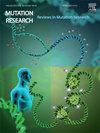A novel mechanism in driving non-small cell lung cancer progression: The METTL3/FOXA1/PTK2 cascade
IF 1.9
4区 医学
Q4 BIOTECHNOLOGY & APPLIED MICROBIOLOGY
Mutation Research-Fundamental and Molecular Mechanisms of Mutagenesis
Pub Date : 2025-06-11
DOI:10.1016/j.mrfmmm.2025.111911
引用次数: 0
Abstract
Background
Dysregulation of m6A modification has significant implications in human carcinogenesis. METTL3, a crucial m6A writer, acts as an oncogenic driver in non-small cell lung cancer (NSCLC). Here, we explored its mechanisms in driving NSCLC development.
Methods
Cell sphere formation, invasion, apoptosis, and proliferation were detected by sphere formation, transwell, flow cytometry, and MTT assays, respectively. Cell glycolysis was evaluated by measuring glucose consumption, lactate production, and ATP/ADP ratio. RIP, methylated RIP (MeRIP), and mRNA stability assays were used to analyze the METTL3/FOXA1 relationship. Luciferase assay and ChIP experiment were used for the evaluation of the FOXA1/PTK2 relationship. Xenograft studies were used to test the role in vivo.
Results
METTL3 was upregulated in NSCLC, and its inhibition diminished the growth, invasiveness, sphere formation ability, and glycolysis of H1299 and A549 cells. Mechanistically, METTL3 depletion caused a reduction in FOXA1 expression through the m6A modification mechanism. FOXA1 transcriptionally controlled PTK2 expression. FOXA1 upregulation reversed the effects of METTL3 inhibition on the growth, invasiveness, sphere formation ability, and glycolysis of H1299 and A549 cells. Moreover, FOXA1 increase attenuated the impact of METTL3 inhibition on the in vivo growth of A549 subcutaneous xenografts. Additionally, increased PTK2 expression counteracted the effects of FOXA1 reduction on the malignant phenotypes of H1299 and A549 cells.
Conclusion
Our finding elucidates a novel mechanism for METTL3’s oncogenic activity in NSCLC, where METTL3 upregulates FOXA1 and thus activates PTK2 transcription. Blocking this cascade may be effective for combating NSCLC.
驱动非小细胞肺癌进展的新机制:METTL3/FOXA1/PTK2级联
m6A修饰的失调在人类癌变中具有重要意义。METTL3是一个重要的m6A转录因子,在非小细胞肺癌(NSCLC)中起着致癌驱动作用。在此,我们探讨了其在推动非小细胞肺癌发展中的机制。方法分别采用成球法、transwell法、流式细胞术和MTT法检测细胞的成球、侵袭、凋亡和增殖。通过测量葡萄糖消耗、乳酸生成和ATP/ADP比值来评估细胞糖酵解。使用RIP、甲基化RIP (MeRIP)和mRNA稳定性分析METTL3/FOXA1的关系。采用荧光素酶法和ChIP实验评价FOXA1/PTK2的关系。异种移植研究被用来测试在体内的作用。结果mettl3在非小细胞肺癌中表达上调,其抑制作用降低H1299和A549细胞的生长、侵袭性、成球能力和糖酵解能力。从机制上讲,METTL3缺失通过m6A修饰机制导致FOXA1表达降低。FOXA1转录控制PTK2的表达。FOXA1上调逆转了METTL3抑制对H1299和A549细胞生长、侵袭性、成球能力和糖酵解的影响。此外,FOXA1的增加减弱了METTL3抑制对A549皮下异种移植物体内生长的影响。此外,PTK2表达的增加抵消了FOXA1减少对H1299和A549细胞恶性表型的影响。我们的发现阐明了METTL3在NSCLC中致癌活性的新机制,其中METTL3上调FOXA1,从而激活PTK2转录。阻断这种级联可能对对抗非小细胞肺癌有效。
本文章由计算机程序翻译,如有差异,请以英文原文为准。
求助全文
约1分钟内获得全文
求助全文
来源期刊
CiteScore
4.90
自引率
0.00%
发文量
24
审稿时长
51 days
期刊介绍:
Mutation Research (MR) provides a platform for publishing all aspects of DNA mutations and epimutations, from basic evolutionary aspects to translational applications in genetic and epigenetic diagnostics and therapy. Mutations are defined as all possible alterations in DNA sequence and sequence organization, from point mutations to genome structural variation, chromosomal aberrations and aneuploidy. Epimutations are defined as alterations in the epigenome, i.e., changes in DNA methylation, histone modification and small regulatory RNAs.
MR publishes articles in the following areas:
Of special interest are basic mechanisms through which DNA damage and mutations impact development and differentiation, stem cell biology and cell fate in general, including various forms of cell death and cellular senescence.
The study of genome instability in human molecular epidemiology and in relation to complex phenotypes, such as human disease, is considered a growing area of importance.
Mechanisms of (epi)mutation induction, for example, during DNA repair, replication or recombination; novel methods of (epi)mutation detection, with a focus on ultra-high-throughput sequencing.
Landscape of somatic mutations and epimutations in cancer and aging.
Role of de novo mutations in human disease and aging; mutations in population genomics.
Interactions between mutations and epimutations.
The role of epimutations in chromatin structure and function.
Mitochondrial DNA mutations and their consequences in terms of human disease and aging.
Novel ways to generate mutations and epimutations in cell lines and animal models.

 求助内容:
求助内容: 应助结果提醒方式:
应助结果提醒方式:


